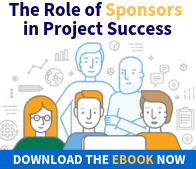Sponsorship is the most critical success factor in ensuring a fast and successful implementation of any type of business change {Tweet This}. But once you’ve identified all your Sponsors through the process of Key Role Mapping, how  do you go about managing them? One of the greatest challenges of implementing large-scale, complex change is that very often you will be confronted with multiple Sponsors who each bring their own visions, political agendas, and "Frames of Reference," to the change.
do you go about managing them? One of the greatest challenges of implementing large-scale, complex change is that very often you will be confronted with multiple Sponsors who each bring their own visions, political agendas, and "Frames of Reference," to the change.
In our 30+ years of Change Management Consulting work, we’ve seen our fair share of Sponsor issues. Here are 4 real-world problem Sponsor scenarios, and some advice on how to handle them.
Scenario #1:
The IT VP, a critical Sponsor, continually says that the benefits of the new technology are inherently wonderful, logical and obvious. Therefore, no resistance is anticipated.
How many times does a Senior Executive, just like this IT VP, send a message to the entire organization, be it on social media, on the program website or in the monthly newsletter, explaining the “brilliant rationale” behind a change. Obviously, once everyone reads this message they will understand why the change is happening, and they will be on board and resistance will be non-existent. Right? Wrong!
In fact, when you over-promise on the benefits of the technology, and under-sell the challenge of actually implementing it, you set yourself up for even greater resistance!
The truth of the matter is that when it comes to implementing any organizational change, whether the change is perceived as negative or positive, reluctance to do things in a new way is inevitable. Resistance is a function of the amount of disruption the change creates for the individual. It’s a way for people to protect themselves against changes in their job tasks, work behaviors, performance measures, power and/or status.
Change Agents should anticipate the more someone believes their current habits and patterns will be impacted, the greater the degree of resistance they will face. Remember, Resistance to Change isn’t logical. It cannot be overcome, combatted, or eliminated. Instead, it must be identified and managed.
Scenario #2:
Your Sponsor has just outlined his/her top priorities for the next year. When challenged, the Sponsor states categorically, “They are all number one!”
We often encounter Sponsors just like this one who claim they’ve never met an initiative they didn’t like. But more often than not they also admit to not being able to deliver these initiatives fast enough, and within budget. There is certainly no shortage of good ideas out there, but what this Sponsor needs to realize is that there is definitely a shortage of resources to implement those ideas. Too many Sponsors are addicted to driving activity instead of focusing on achieving value realization for the most critical strategic initiatives.
That’s why it is so important to have a clear line of sight to the total number of projects that are in play, where resources are being spent, and the prioritization and sequencing of each initiative. We tell leaders all the time that they need to "focus down to speed up." What we mean is that to go faster, you have to actually slow down by having fewer initiatives on the organizational change plate at the same time. It may sound counter-intuitive, but slowing down ultimately results in greater speed.
Scenario #3:
Your Sponsor has declared that since “Go Live” and “Lights On” are just two weeks away, Change Management expertise is not needed.
An “installation mentality” which considers achieving launch or “go live” as the strategic-end goal is unfortunately, a common phemonenon. But we call this “pre-mature project completion,” because the project ends before what should be the real goal has been achieved. What’s missing in this Sponsor’s thinking? Return on Investment! There is a simple value equation:
No behavior change = No true change = No Return on Investment
There are 5 metrics that define a “successful” project:
- On Time
- On Budget
- All Technical Objectives Met
- All Business Objectives Met
- All Human Objectives Met
Ensuring the last two bullet points (business and human objectives are met) is the difference between installation and implementation. Implementation is much more likely when there is sufficient rigor and discipline on the human side of organizational changes, using a repeatable Change Management Process like the Accelerating Implementation Methodology (AIM).
Scenario #4:
Your Sponsor says that his/her mid-managers will naturally support the change because it is good for the business.
This is one of the biggest paradoxes in implementing organizational changes, particularly enterprise-wide change or transformational change. What this Sponsor doesn’t realize is that middle and upper level managers, the people we rely on the most to Sponsor change, are the very people who may have the most overt and covert resistance to it!
Why is this? One of the key principles in the (AIM) is, “You can expect the most resistance from those people who have the greatest vested interest in keeping things the same.” More often than not, these people are your middle to upper level managers who have been hired and been successful by maintaining the status quo.
Change Agents should not assume that these managers are aligned with the change simply by virtue of their organizational position. These Sponsors need to have the same two questions answered as any Target. What's this change mean to me, and what's in it for me?
These are just 4 examples of the countless Sponsorship challenges we help our clients solve all the time. Do you have the strategies and tactics you need to mitigate these risks in your organization?


